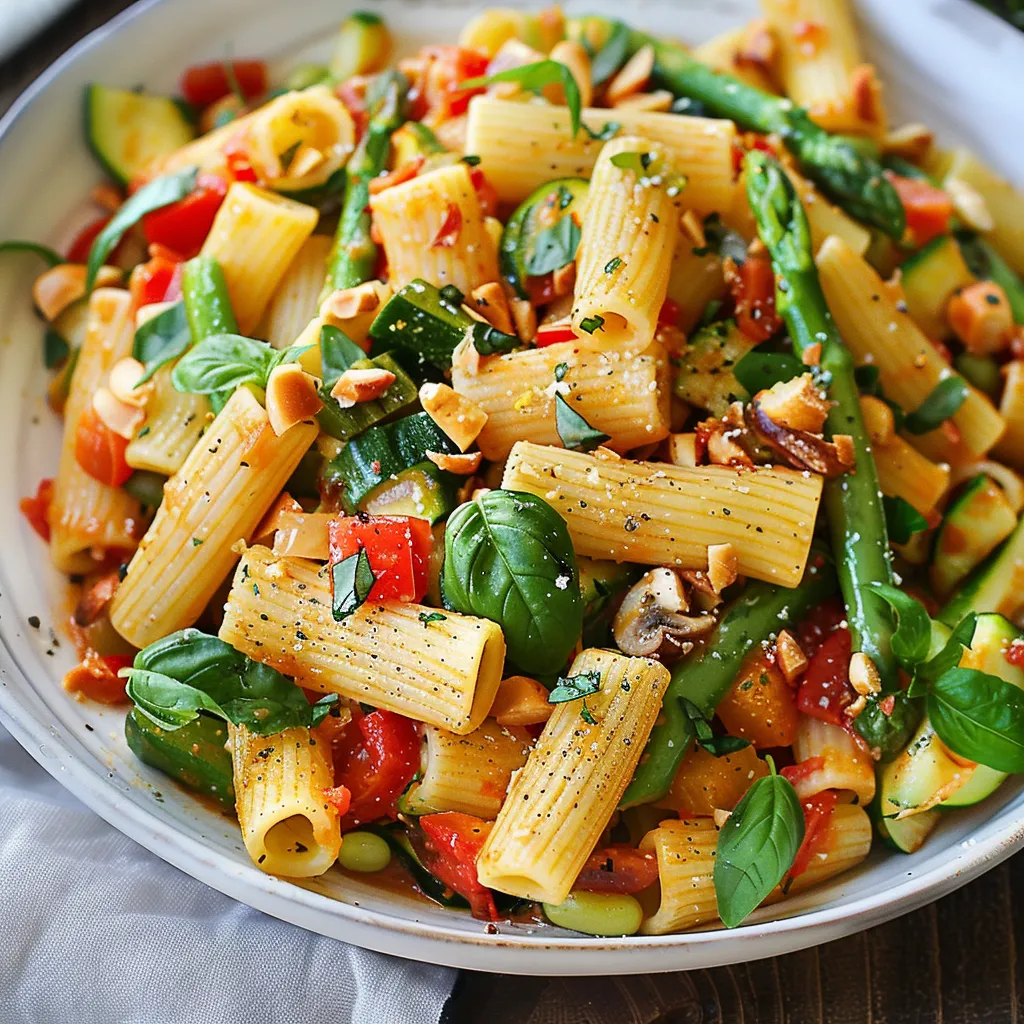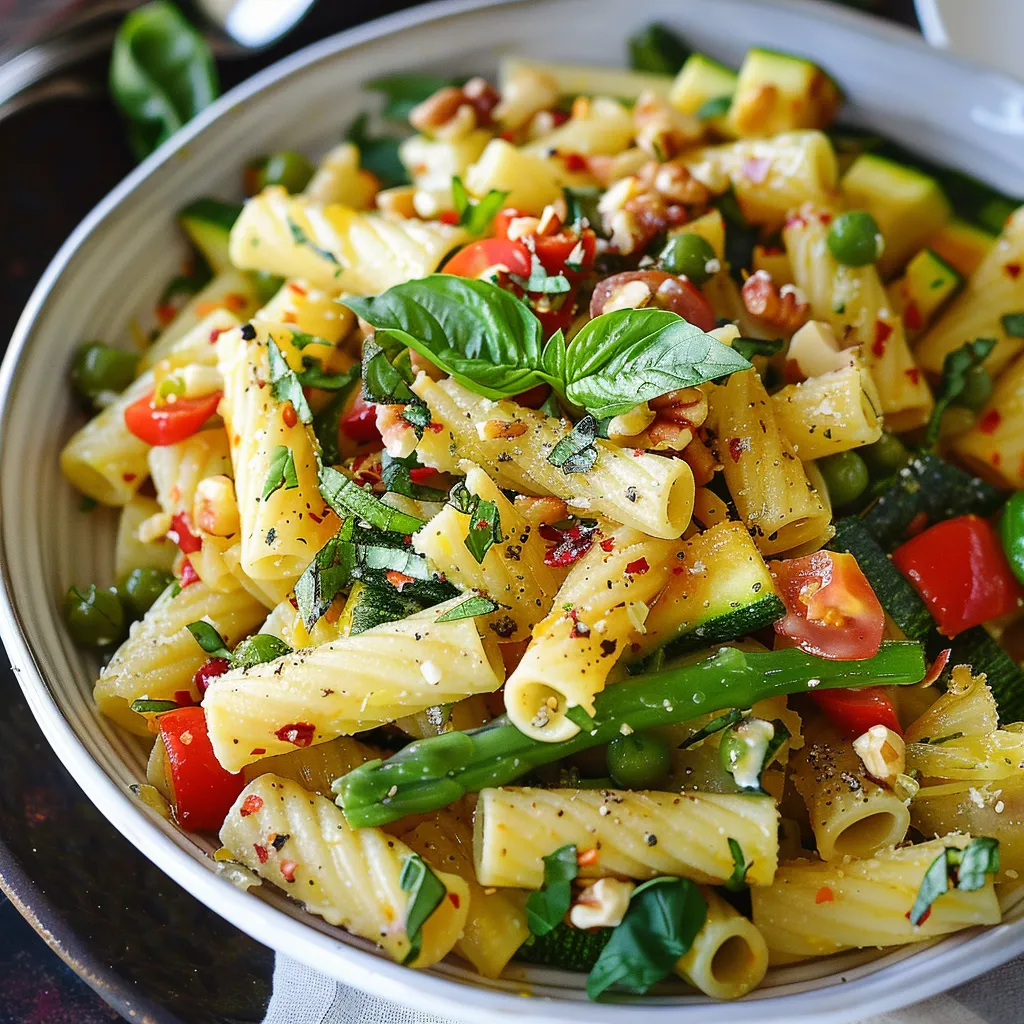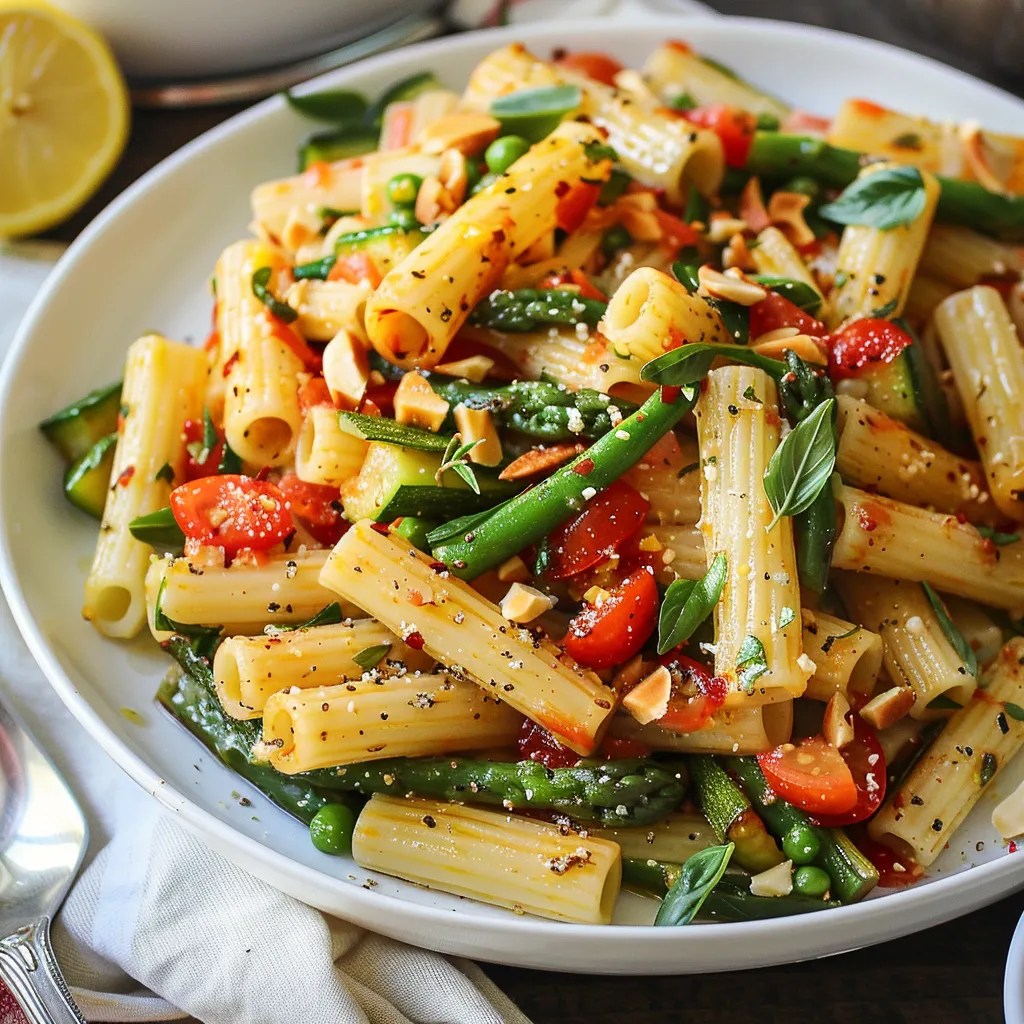 Pin to Favorites
Pin to Favorites
The moment you take your first twirl of Vegan Pasta Primavera, your fork captures a rainbow of vegetables suspended in a silky, bright lemon cream sauce that clings perfectly to each al dente rigatoni ridge. The vibrant colors hint at the explosion of flavors and textures that follows—tender-crisp asparagus and snow peas alongside juicy cherry tomatoes and the gentle bite of red peppers and zucchini. This plant-based adaptation of the classic Italian-American dish delivers everything you love about the original with a lighter, fresher approach that celebrates the natural beauty of spring and summer produce while still providing that creamy, satisfying pasta experience you crave.
Last weekend, I served this at a dinner party alongside some crusty bread, and even my non-vegan friends were scraping their plates clean. There's something magical about how the bright, lemony sauce enhances the natural flavors of each vegetable while creating a cohesive, crave-worthy dish.
Essential Ingredients and Selection Tips
- Vegetables: Look for the freshest, most vibrant produce for maximum flavor and nutrition. Asparagus should have tight, firm tips and slender stalks. Cherry tomatoes should be plump and aromatic. Zucchini should feel firm and heavy for its size.
- Oat Milk: Choose a full-fat, extra creamy unsweetened variety for the best sauce consistency. Barista blends work particularly well as they're formulated to withstand heat without separating.
- Nutritional Yeast: This optional ingredient adds a subtle cheesy flavor that deepens the sauce. Look for fortified varieties that provide vitamin B12, an important nutrient for those following a plant-based diet.
- Pasta: Rigatoni is excellent for catching sauce in its ridges and tubes, but any pasta shape with texture works beautifully. Consider whole wheat or legume-based options for additional fiber and protein.
 Pin to Favorites
Pin to Favorites
Detailed Cooking Instructions
- Step 1: Prepare Your Mise en Place
- Chop all vegetables into similar sizes for even cooking. Trim asparagus, dice red bell pepper and zucchini, halve cherry tomatoes, and prepare snow peas. Mince the shallot and garlic, zest and juice one lemon, keeping them separate.
- Step 2: Cook the Pasta
- Bring a large pot of salted water to a rolling boil. Cook 12 ounces of rigatoni until al dente, about 12 minutes. Reserve 1 cup of pasta water before draining.
- Step 3: Sauté the Vegetables
- Heat 2 tablespoons grapeseed oil in a large skillet over medium heat. Add asparagus, red bell pepper, zucchini, snow peas, and frozen peas. Sauté for 7 minutes, stirring occasionally, until tender-crisp. Add cherry tomatoes last. Season with salt and pepper. Transfer to a bowl.
- Step 4: Create the Lemon Cream Sauce
- In the same skillet, heat 1 tablespoon grapeseed oil over medium heat. Add diced shallot and sauté for 3 minutes. Add minced garlic and lemon zest, stirring for 30 seconds. Pour in ½ cup vegetable broth and simmer until reduced by half.
- Step 5: Finish the Sauce
- Reduce heat to medium-low. Slowly pour in 1 cup oat milk while stirring. Add 2 tablespoons lemon juice and 2 tablespoons nutritional yeast if using. Simmer for 2-3 minutes until creamy.
- Step 6: Combine and Coat
- Add cooked pasta and sautéed vegetables back into the skillet. Toss gently to coat everything in the sauce. Simmer for 1-2 minutes. Add pasta water if needed to adjust consistency.
- Step 7: Garnish and Serve
- Transfer to a serving dish. Garnish with ¼ cup chopped walnuts, 2 tablespoons fresh basil, and 2 tablespoons parsley. Sprinkle red pepper flakes for heat if desired. Serve immediately.
My first attempt at this dish taught me that drowning the vegetables in sauce loses their individual character. Now I aim for a lighter coating that complements rather than overwhelms the produce, allowing each vegetable to shine while still creating a cohesive dish.
I once made the mistake of overcooking the vegetables until they were soft and indistinct, losing the vibrant colors and textural contrast that make this dish special. Now I set a timer and remain vigilant, knowing that maintaining that tender-crisp quality is essential to the dish's success.
Final Thoughts
This Vegan Pasta Primavera honors the spirit of the original 'springtime pasta' created in the 1970s at New York's famed Le Cirque restaurant. While traditional primavera uses cream and cheese, this plant-based adaptation captures the same celebration of fresh, seasonal produce in a more contemporary, lighter approach. The Italian-American original was revolutionary in highlighting vegetables as the star rather than the side dish—a philosophy that aligns perfectly with modern plant-forward eating.
What makes this dish truly special is how it transforms everyday vegetables into something extraordinary through thoughtful preparation and a luxurious yet light sauce. The variety of colors, textures, and flavors creates a meal that's deeply satisfying without being heavy. I've served this to skeptics of plant-based cooking who have been genuinely surprised by how complete and satisfying the experience is—proof that vegan cuisine can be both nourishing and indulgent.
I serve this vibrant pasta in shallow bowls that showcase the rainbow of vegetables, often with a simple green salad and crusty bread alongside. The leftover portions make perfect packed lunches for the next day, tasting delicious whether reheated or enjoyed cold as a pasta salad. This adaptability makes it not just a delightful dinner but a practical addition to your cooking repertoire that serves multiple purposes throughout the week.
 Pin to Favorites
Pin to Favorites
Frequently Asked Questions
- → What vegetables work best in this Vegan Pasta Primavera?
- While the recipe suggests asparagus, bell pepper, zucchini, snow peas, and cherry tomatoes, you can use any seasonal vegetables you have on hand. Broccoli, mushrooms, spinach, artichoke hearts, or summer squash would all work well. The key is to maintain the colorful variety that makes primavera special.
- → Can I substitute the oat milk in this recipe?
- Yes, you can substitute oat milk with any unsweetened plant milk like almond, soy, or cashew milk. For the creamiest results, look for a barista or full-fat version of your preferred plant milk. Coconut milk will add a coconut flavor but works well if you enjoy that taste.
- → What can I use instead of nutritional yeast?
- If you don't have nutritional yeast, you can use vegan Parmesan cheese or simply omit it. The nutritional yeast adds a subtle cheesy flavor and helps thicken the sauce, but the dish will still be delicious without it.
- → What pasta shapes work best for this Vegan Pasta Primavera?
- While the recipe calls for rigatoni, any medium-sized pasta shape that can catch the sauce works well. Try penne, fusilli, farfalle (bow ties), or rotini. You can also use gluten-free pasta if needed without any other recipe adjustments.
- → How can I make this Vegan Pasta Primavera more substantial?
- To make this dish even more filling, add plant-based protein such as white beans, chickpeas, or bite-sized pieces of tofu or tempeh. You could also add nuts like pine nuts or walnuts for extra protein, healthy fats, and a delightful crunch.
